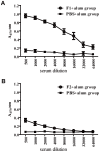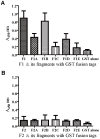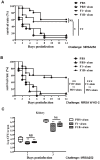Identification of the immunodominant regions of Staphylococcus aureus fibronectin-binding protein A
- PMID: 24736634
- PMCID: PMC3988184
- DOI: 10.1371/journal.pone.0095338
Identification of the immunodominant regions of Staphylococcus aureus fibronectin-binding protein A
Abstract
Staphylococcus aureus is an opportunistic bacterial pathogen responsible for a diverse spectrum of human diseases and a leading cause of nosocomial and community-acquired infections. Development of a vaccine against this pathogen is an important goal. The fibronectin binding protein A (FnBPA) of S. aureus is one of multifunctional 'microbial surface components recognizing adhesive matrix molecules' (MSCRAMMs). It is one of the most important adhesin molecules involved in the initial adhesion steps of S. aureus infection. It has been studied as potential vaccine candidates. However, FnBPA is a high-molecular-weight protein of 106 kDa and difficulties in achieving its high-level expression in vitro limit its vaccine application in S. aureus infection diseases control. Therefore, mapping the immunodominant regions of FnBPA is important for developing polyvalent subunit fusion vaccines against S. aureus infections. In the present study, we cloned and expressed the N-terminal and C-terminal of FnBPA. We evaluated the immunogenicity of the two sections of FnBPA and the protective efficacy of the two truncated fragments vaccines in a murine model of systemic S. aureus infection. The results showed recombinant truncated fragment F130-500 had a strong immunogenicity property and survival rates significantly increased in the group of mice immunized with F130-500 than the control group. We futher identified the immunodominant regions of FnBPA. The mouse antisera reactions suggest that the region covering residues 110 to 263 (F1B110-263) is highly immunogenic and is the immunodominant regions of FnBPA. Moreover, vaccination with F1B110-263 can generate partial protection against lethal challenge with two different S. aureus strains and reduced bacterial burdens against non-lethal challenge as well as that immunization with F130-500. This information will be important for further developing anti- S. aureus polyvalent subunit fusion vaccines.
Conflict of interest statement
Figures







Similar articles
-
Novel peptides screened by phage display peptide library can mimic epitopes of the FnBPA-A protein and induce protective immunity against Staphylococcus aureus in mice.Microbiologyopen. 2019 Oct;8(10):e910. doi: 10.1002/mbo3.910. Epub 2019 Aug 26. Microbiologyopen. 2019. PMID: 31452334 Free PMC article.
-
Fine-mapping of immunodominant linear B-cell epitopes of the Staphylococcus aureus SEB antigen using short overlapping peptides.PLoS One. 2014 Mar 5;9(3):e90445. doi: 10.1371/journal.pone.0090445. eCollection 2014. PLoS One. 2014. PMID: 24599257 Free PMC article.
-
Identification of a novel linear B-cell epitope as a vaccine candidate in the N2N3 subdomain of Staphylococcus aureus fibronectin-binding protein A.J Med Microbiol. 2018 Mar;67(3):423-431. doi: 10.1099/jmm.0.000633. Epub 2018 Jan 18. J Med Microbiol. 2018. PMID: 29458526
-
Vaccine potential of poly-1-6 beta-D-N-succinylglucosamine, an immunoprotective surface polysaccharide of Staphylococcus aureus and Staphylococcus epidermidis.J Biotechnol. 2000 Sep 29;83(1-2):37-44. doi: 10.1016/s0168-1656(00)00296-0. J Biotechnol. 2000. PMID: 11000458 Review.
-
Development of a vaccine against Staphylococcus aureus invasive infections: Evidence based on human immunity, genetics and bacterial evasion mechanisms.FEMS Microbiol Rev. 2020 Jan 1;44(1):123-153. doi: 10.1093/femsre/fuz030. FEMS Microbiol Rev. 2020. PMID: 31841134 Free PMC article. Review.
Cited by
-
The Multivalent Role of Fibronectin-Binding Proteins A and B (FnBPA and FnBPB) of Staphylococcus aureus in Host Infections.Front Microbiol. 2020 Aug 26;11:2054. doi: 10.3389/fmicb.2020.02054. eCollection 2020. Front Microbiol. 2020. PMID: 32983039 Free PMC article. Review.
-
Analysis of colostrum IgA against bacteria involved in neonatal infections.Einstein (Sao Paulo). 2017 Jul-Sep;15(3):256-261. doi: 10.1590/S1679-45082017AO3958. Einstein (Sao Paulo). 2017. PMID: 29091144 Free PMC article.
-
Functional diversity of staphylococcal surface proteins at the host-microbe interface.Front Microbiol. 2023 May 18;14:1196957. doi: 10.3389/fmicb.2023.1196957. eCollection 2023. Front Microbiol. 2023. PMID: 37275142 Free PMC article. Review.
-
Novel peptides screened by phage display peptide library can mimic epitopes of the FnBPA-A protein and induce protective immunity against Staphylococcus aureus in mice.Microbiologyopen. 2019 Oct;8(10):e910. doi: 10.1002/mbo3.910. Epub 2019 Aug 26. Microbiologyopen. 2019. PMID: 31452334 Free PMC article.
-
The Two-Track Investigation of Fibronectin Binding Protein A of Staphylococcus aureus from Bovine Mastitis as a Potential Candidate for Immunodiagnosis: A Pilot Study.Int J Mol Sci. 2023 Mar 31;24(7):6569. doi: 10.3390/ijms24076569. Int J Mol Sci. 2023. PMID: 37047541 Free PMC article.
References
-
- Taccetti G, Cocchi P, Festini F, Braggion C, Campana S (2010) Community-associated meticillin-resistant Staphylococcus aureus. Lancet 376: 767–768. - PubMed
-
- Durai R, Ng PC, Hoque H (2010) Methicillin-resistant Staphylococcus aureus: an update. AORN J 91: : 599–606; quiz 607–599. - PubMed
-
- Klevens RM, Morrison MA, Nadle J, Petit S, Gershman K, et al. (2007) Invasive methicillin-resistant Staphylococcus aureus infections in the United States. JAMA 298: 1763–1771. - PubMed
-
- Diekema DJ, Pfaller MA, Schmitz FJ, Smayevsky J, Bell J, et al. (2001) Survey of infections due to Staphylococcus species: frequency of occurrence and antimicrobial susceptibility of isolates collected in the United States, Canada, Latin America, Europe, and the Western Pacific region for the SENTRY Antimicrobial Surveillance Program, 1997–1999. Clinical infectious diseases: an official publication of the Infectious Diseases Society of America 32 Suppl 2: S114–132. - PubMed
Publication types
MeSH terms
Substances
LinkOut - more resources
Full Text Sources
Other Literature Sources

